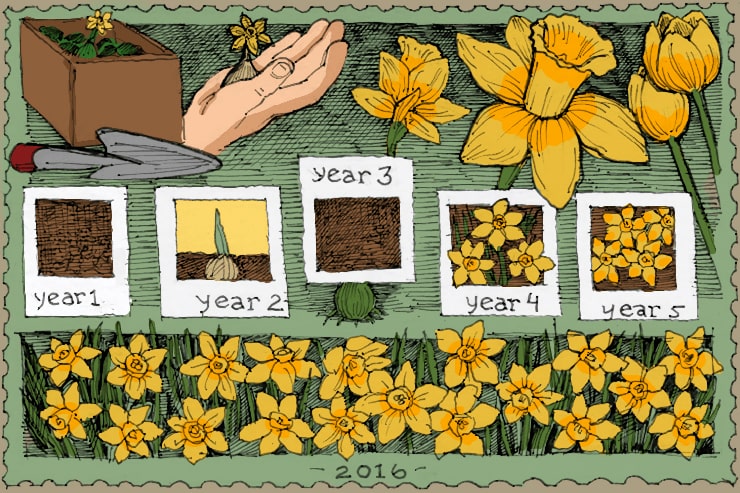Who can resist little daffodils, with their bright yellow baby faces? What a perfect choice for a ribbon of space between the side yard chain-link fence and the sidewalk. And delightful they were the next year, a row of little sunbeams to cheer passersby. But the flowers faded and I wanted to plant portulaca starts in the same strip. So I dug the little bulbs and put them in a small box in the shed to replant later.
Summer is a busy time, as any gardener knows, and other distractions abound. Somehow I forgot about the little bulbs.
A year or so later, I was checking the contents of several small boxes in the shed when—Oh no! I was dismayed to find the little daffodil bulbs, dry and hopeless. But wait—in the very center of the pile—a gleam of color! Attached directly to one of the bulbs was a tiny perfect flower, only three inches tall and all dried out but still yellow.
You bloomed? I thought. In a box? In the dark? With no dirt? You bloomed? I held the ball with its brave little flower cup in my hand, imagining it gritting its little daffodil teeth when it knew, somehow, spring was coming and thinking, “I will not die yet—I will bloom again if it is the last thing I do!” And did. Its companions were crunchy goners. But you, I thought, deserve a second chance.
I planted the little bulb near a family of Apeldoorn tulips at the edge of the pea bed. I’m sorry, I thought, this is the best I can do.
The next year the King Alfred daffodils came charging up in the beeyard as they had for many years (the bees were gone, but we still called it the beeyard), and I kept watch over the spot where the little bulb lay, watching hopefully for a green shoot to appear.
It didn’t happen. The undisturbed soil was a mute reminder of my forgetfulness. Well, what did you expect, I thought. The poor little thing spent every molecule of life it had for that last bloom. In a box. In the dark. With no dirt. (Wince.) I left the spot alone. Rest in peace.

The following year I had almost forgotten about the little daffodil. At the beeyard the King Alfreds were elbowing the lavender and the Apeldoorn leaves barely yawning at the sky when I rounded the edge of the pea bed and happened to glance down. I stopped and stared. A little shaft of green was rising out of the ground exactly where I had planted the tiny bulb. I bent down for a closer look. It was definitely daffodil. “Look at me!” It seemed to shout. “I am alive!” Joyfully I awaited the bloom.
It didn’t happen. OK, I thought, it is still recovering. I will be happy for now just knowing it is still alive. It will bloom next year for sure! Summer and fall go by quickly here in western Oregon, and winters are mercifully short. We are gardening into November and back at it again in February. So it seemed in no time the King Alfreds were playing follow-the-leader around the beeyard and I was watching the end of the pea bed waiting for another green shoot to appear. And bloom.
It didn’t happen. Where are you? I thought. You were supposed to bloom this year, and you don’t even come up? Was last year a last hurrah? A sign to tell me I am forgiven? What? I kept watching even as the noble Apeldoorns lit up the pea bed. They seemed to say, “See how it’s done? Join us!” There was no response.
Another winter passed. At the beeyard the King Alfreds were singing their golden song to the sky, and my mind was on planting peas as I went by the faithful Apeldoorns. Out of the corner of my eye—a flash of yellow. Whoa! I backed up and looked down. Looking back at me were not one, not two, but three cheerful little daffodils. I almost whooped for joy—and it seemed I heard them giggle.
So what happened? I’m no expert, but here’s what I think. The first year back in the ground the bulb concentrated on recovery: rehydrating, growing roots, and restoring healthy tissue. There simply was not enough energy to grow foliage, let alone bloom. The second year the stalk appeared to get some badly needed photosynthesis. The third year nothing happened aboveground because the bulb was concentrating on doing what bulbs are programmed to do—make more bulbs.
It turned out those three little flowers marked the end of the peekaboo growth pattern. The following year the little daffodils came up and bloomed right on schedule, and each year after there were more. In 2014 there were nine blossoms, in 2015 there were 13, and in 2016 a thick clump of green with 19 blooms told me it was past time to divide (and—ahem—immediately replant) what has to be the toughest little daffodil on the planet.
So in November up came the clump. I counted 23 bulbs, including four that had expired. In the center of the clump was Mama, and there was no mistaking her. A balmy fall had prompted the bulbs to start sprouting and Mama alone had two, which were twice as tall as the others. I planted the family in a circle with Mama in the center where she belongs, that defiant “V” thrust above a mulch of leaves saying, “Now you just watch me!”
I can hardly wait. ❖
This article was published originally in 2017, in GreenPrints Issue #109.



